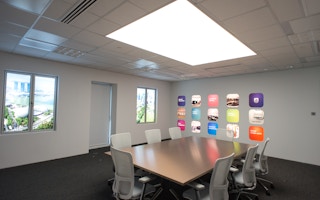Imagine walking into your favourite retail outlet and opening its app. As soon as a map appears on screen to show your in-store position, discount coupons pop up while you browse, and the location of the items you want can be instantly pinpointed.
The technology to make all this happen is already here. Known as visible light communication (VLC), it is one of the many cutting-edge lighting technologies on show at Philips Lighting’s Lighting Application Center (LAC) that opened in Singapore early this month.
It is the company’s first showroom in Southeast Asia and also its most updated one of connected lighting and Internet of Things (IoT) technology.
Located at the Philips APAC Center in Singapore, the 492 sq m LAC is divided into various zones mimicking scenes from daily life including an office, a sports stadium, public streets, a hotel room, and a retail outlet, and demonstrates how Philips lights can enhance or impact an experience of the place.
The LAC, which cost approximately S$1.75 million to develop, is more than 80 per cent covered in LED lights that have interactive or connective capabilities.
Speaking at the opening ceremony of the LAC, Eric Rondolat, CEO of Philips Lighting, explained the company’s choice to open the LAC in Singapore. “When we talk about innovation, we need to find the hotspots of the world, where we feel at ease to display and develop our innovation, and this is why we are in Singapore today,” he said.
“Singapore is a very important place for us because it is a place where technology’s important, where ambition is paramount, and this is a country that has a stated goal to become the world’s No. 1 Smart Nation.”
Besides the LAC in Singapore, other comparable LACs in terms of size are located in Eindhoven in the Netherlands, Lyon in France, and Chengdu in China.
The opening of the LAC in Singapore is timely given the growing demand for IoT technology and connected systems within the Asia-Pacific region and its launch is a boost in Singapore’s drive to become a Smart Nation.
According to market research company IDC, the market for IoT across Asia-Pacific excluding Japan will grow to a value of US$583 billion by 2020, with China dominating a 59 per cent lion’s share of market opportunities. The Asia IoT Business platform, which advocates IoT adoption in business within Southeast Asia, has predicted that IoT spend in the Philippines and Malaysia will reach US$766.8 million by 2020 and US$10.5 billion by 2025 respectively.
While there are no specific statistics on the demand for connected lighting per se, Philips Lighting predicts a 70 per cent increase in the number of points for lighting fixtures by 2050 based on trends in population growth and urbanisation, which provides opportunities for the installation and use of connected lighting systems.
The LAC launch also dovetails with Singapore’s ambition to become a Smart Nation. Patricia Yim, market leader of Philips Lighting ASEAN Pacific, told Eco-Business that lighting plays a role in the Smart Nation vision in three main ways: connectivity between devices or systems; improving the lives of users for more efficient and sustainable economies; and the role of innovation when it comes to bettering the lives of people.
“It’s not connectivity for the sake of connectivity, because light is always needed,” she emphasised. “It’s about (having) a test bed. If I told you light can communicate, that it can be controlled, you can’t imagine it. But take a tour in the LAC and you see possibilities.”
“
People always think sustainability is about being green or energy saving, but it is also about improving lives.
Patricia Yim, market leader, Philips Lighting ASEAN Pacific
What captured her imagination about the future is the fact that something as essential as light could be repurposed and offer more value to people by performing multiple functions such as generating data through connected lighting.
Two of the new technologies on display at the LAC that generated the most interest from the audience at last week’s launch included VLC and Power-Over-Ethernet (PoE), both of which offer more than illumination.
The first, VLC, is an indoor positioning technology that acts like a GPS system and allows a person to share his physical location with others through an app, and has potential within a retail setting.
The other, PoE, gives office workers the ability to control office temperature and light through smartphone apps. It can also sense occupancy levels, lighting usage, and daylight levels within a room and therefore automatically adjust the brightness of the lights for energy savings.
These are just two of the technologies on display at the LAC. Besides giving people new ways to shop and work, these technologies also introduce innovative ways to be sustainable.
Expanding on Philips Lighting’s CSR approach, Yim said the company advocates LEDification and connectivity, which reduces energy usage by up to 70 per cent compared to traditional lights. Lighting currently accounts for 19 per cent of global electricity consumption.
Secondly, Yim said she has seen cases where workplace accidents are lower and productivity increased as a result of better lighting, which is what Philips Lighting offers. The company has also pledged to sell two billion high-efficiency and affordable light bulbs to reduce energy usage around the world to do its part against climate change.
Third are the “more obvious” projects such as installing solar power capabilities in countries where there is no electricity grid, thus allowing societies to leapfrog that stage of development.
Besides that, the lighting company has also pledged to make its global operations carbon neutral by as soon as 2020.
Yim said: “We believe sustainability is beyond energy savings… People always think sustainability is about being green or energy saving, but it is also about improving lives.”

















